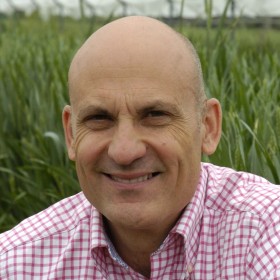
Research interests
Understanding the physiological limitations to yield formation and the adaptations of plants to abiotic stresses such as drought. The current research emphasis is on wheat, although past work involved maize, oats, sugar beet and tropical legumes. New information and tools are needed to increase food production and the effective use of water.
One key area is identifying superior germplasm under field conditions using advanced phenotyping techniques. This work is done in close collaboration with commercial plant breeders. Other related projects were initiated in response to needs by the agriculture industry and funded almost entirely by industry partners. Earlier work involved studying the role of drought-induced abscisic acid (ABA) in regulating maize endosperm development and cell division, kernel growth, and genes for carbohydrate metabolism and storage proteins.
Further studies were on the role of ABA in regulating maize root growth maintenance, osmotic adjustment, and signalling changes in rhizosphere water availability at the cell membrane level. Root tissue O2 relations were also studied by inventing an O2 microsensor. Expertise is in the areas of crop physiology, field phenotyping, plant water relations, regulation of growth and grain development during water deficit, and hormonal regulation of root growth and osmotic adjustment.
Research Projects
IWYP2: Rooty-A root ideotype toolbox to support improved wheat yields: Duration: Nov 2018- Oct 2021; Partners: NIAB (lead), CIMMYT, Forschungszentrum Jülich, John Innes Centre, Justus Liebig University Giessen, University of Bologna, University of Queensland; Funding: BBSRC/IWYP/DFID (BB/S012826/1)
BioLaser: Establishing a High-Resolution Laser Ablation Tomography Platform for UK Bioimaging Research: Duration: Nov 2017- Oct 2019; Partners: NIAB (lead), University of Cambridge-Institute for Manufacturing; Funding: BBSRC (BB/P027458/1).
Extending Knowledge Of Increased Corn Crop Productivity To Farmers: Duration: August 2017-July 2020; Partners: University of Cambridge (lead), NIAB, Punjab Agricultural University, FieldFresh; Funding: Bharti Foundation through FieldFresh Foods Private Limited
PHOTOWHEAT: Exploiting variation in stomatal dynamics and ear photosynthesis to optimise wheat productivity: Duration: 1/9/16 to 31/8/19; Partners: NIAB, University of Essex, BASF; Funding: BBSRC (BB/N01698X/1)
SoilCards: Duration: 1/9/17 to 31/3/20; Partners: NIAB, Science Practice Ltd, Kenya Agriculture and Livestock Research Organisation (KALRO); Funding: Cambridge-Africa Alborada Research Fund
WHEALBI: WHEAT and barley Legacy for Breeding Improvement: Duration: 1/1/14 to 31/12/18; Partners: NIAB, multiple partners; Funding: EU FP7 (613556)
Optimising oat yield and quality to deliver sustainable production and economic impact (Opti-Oat): Duration: 15/3/15 to 28/2/19; Partners: PepsiCo (lead), Environment Systems, Ltd., NIAB, ADAS, Aberystwyth University, James Hutton Institute; Funding: BBSRC/Innovate UK (BB/M027368/1)
GplusE: Genomic selection and Environment modelling for next generation wheat breeding: Duration: 15/1/15 to 25/1/18; Partners: NIAB, Roslin Institute, KWS UK, RAGT Seeds, Limagrain, Elsoms Seeds; Funding: BBSRC (BB/L022141/1)
Publications
Recent publications
Camargo Rodriguez VA, Ober ES. AquaCropR: Crop Growth Model for R. (2019) Agronomy 9: 378
Roitsch T, Cabrera-Bosquet L, Fournier A, Ghamkhar K, Jiménez-Berni J, Pinto F, Ober ES. Review: New sensors and data-driven approaches - a path to Next Generation Phenomics. (2019) Plant Science
Gaynor RC, Gorjanc G, Bentley AR, Ober ES, Howell P, Jackson R, Mackay IJ, Hickey JM. A two-part strategy for using genomic selection to develop inbred lines. (2017) Crop Science 57: 2372-2386.
Whalley WR, Binley A, Watts CW, Shanahan P, Dodd IC, Ober ES, Ashton RW, Webster CP, White RP, Hawkesford MJ. Methods to estimate changes in soil water for phenotyping root activity in the field. (2017) Plant and Soil 415:407–422.
Mackay I, Ober E, Hickey J. GplusE: beyond genomic selection. (2015) Food and Energy Security 4:24-35.
Full publication list on Google Scholar, ORCID, Scopus, ResearchGate
Eric on LinkedIn
